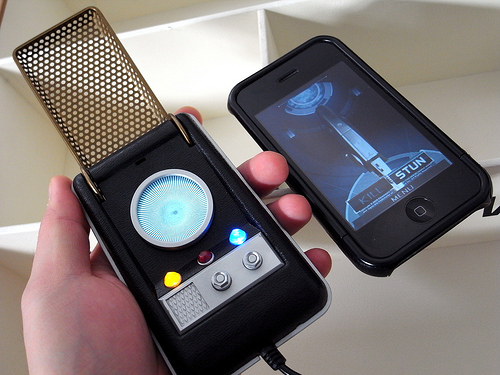You’re probably at least somewhat familiar with science fiction in concept. Whether it’s the epic science-fantasy of Star Wars, the dark futurism of Blade Runner, the early modern horror of Frankenstein, or even the absurdism of the Hitchhiker’s Guide books, sci-fi is one of the most pervasive and popular fiction genres.
Sci-fi can be incredibly entertaining; however, it’s not just about entertainment. Many see the sci-fi genre as a way to comment about our world, explore ideas, or even seed innovation. And if we look at some recent innovations, we see how that vision came about.

Sci-Fi Inspires Real-Life Innovation
Often, even without a creator’s intent, our world takes on influence directly from works of science fiction. For example, consider the incredible impact of Star Trek. Engineer Martin Cooper cites Captain Kirk’s communicator as the inspiration that eventually led him to develop the world’s first cell phone. Similarly, an episode of Star Trek: The Next Generation is what gave Karlheinz Brandenburg the idea to develop a digital music file, eventually introducing the MP3 format.
Those are a couple of the more sensational examples. However, sci-fi has a profound impact on how we live every day. For young people, it can even become a lifelong passion.
Many students see the possibilities for the future reflected in science fiction, and take it upon themselves to try and shape the future to reflect their vision. As a result, many end up studying in STEM-related fields. As NASA Flight Controller Stephanie Seuffert Breen explains:
“Honestly, when I was a kid there was a Sci-Fi TV show that I absolutely loved, called Stargate SG-1. Watching that show gave me a huge interest in space travel and sciences, especially through their very strong female character Samantha Carter. That character inspired me to choose a path in STEM and become an engineer.”
Teachers Bringing Sci-Fi Into the Classroom
Educational institutions are beginning to understand the impact science fiction has on how we think of science in general. In response, some are now using sci-fi to help teach STEM-related classes. Kenyon University, for example, introduced a Biology in Science Fiction class several years ago. The idea was to engage students in learning about biology through the lens of sci-fi.
It doesn’t have to wait for the college, though. Brining more sci-fi into science and math lessons at the high school level, or even earlier, can help teachers engage students and inspire a passion for STEM at an early age.
This lesson guide from the Yale-New Haven Teachers’ Institute outlines how to incorporate sci-fi into lessons for middle school-aged students. While the plan won’t fit in every scenario, it provides valuable insight on the subject.
There are multiple reasons why we’re experiencing trouble recruiting students, especially female and non-white students, into STEM education. Making the subjects a little more engaging for students won’t solve the problem. However, it may help inspire students to take another look at science and mathematics.
In the end, students could see there’s more to it than they might realize. Who knows? Someone in your class right now may develop the defining technology of the 21st Century.
